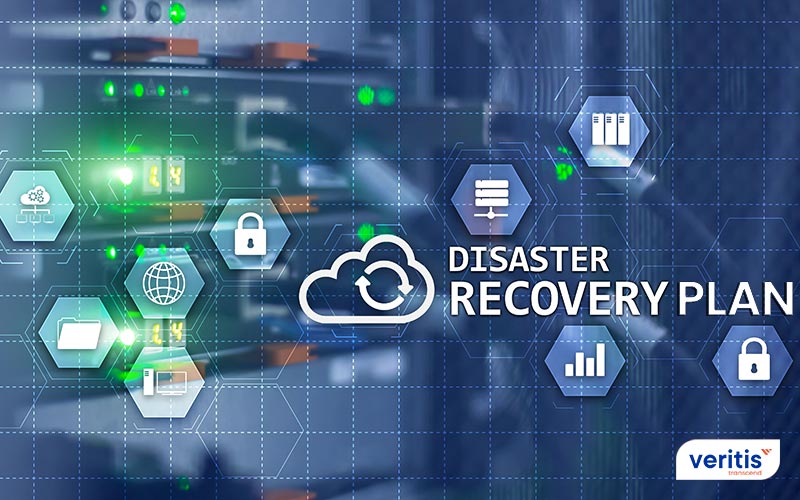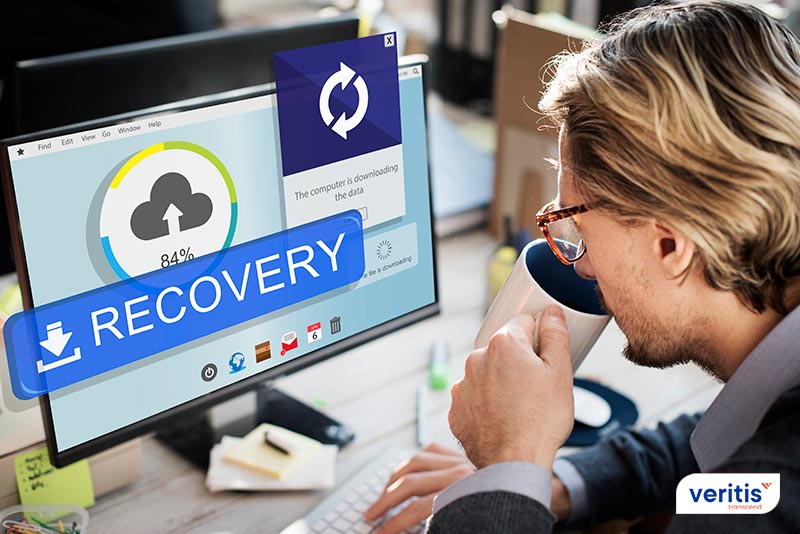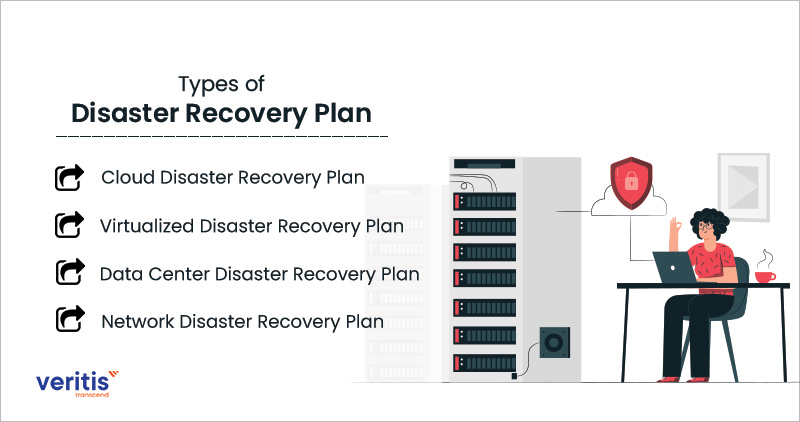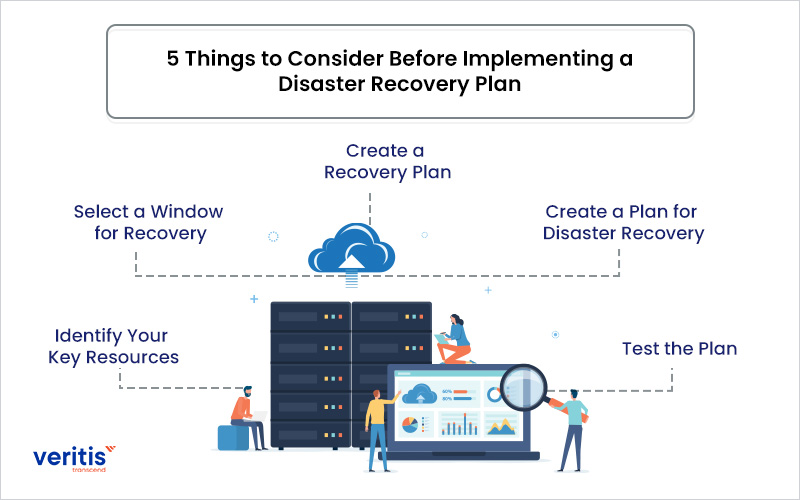
Businesses employ information technology to process information quickly and efficiently. Employees communicate through voice over internet protocol (VoIP) telephone networks and electronic mail. One company to another can exchange data, including orders and payments, through electronic data interchange (EDI). Servers handle information processing and data archiving. Employees use electronic devices to generate, manage and communicate information. What actions do you take if your information technology infrastructure breaks down?
Creating an Information Technology disaster recovery plan (IT DRP) should go hand in hand with creating a business continuity strategy. First, the business impact analysis should be used to establish IT priorities and recovery time goals. Then, technology recovery plans should be created to restore hardware, and software components without latency and support them with the required datasets to fulfill business recovery requirements.
Large volumes of information or data are produced and managed by businesses of all sizes. Much of that data is proprietary, and such information is essential to the survival and ongoing operation of the firm. The consequences of data loss or corruption due to hardware malfunction, human error, hacking, or virus would be severe. Therefore, it’s crucial to have a plan for data backup disaster recovery system, and restoration of electronic information.
An organization’s comprehensive disaster recovery (DR) strategy outlines how to deal with unanticipated events, including natural disasters, power outages, cyberattacks, and other disruptive occurrences. The IT DR plan includes measures to lessen the effects of a disaster so that a business can carry on or soon restart essential functions.
Disgruntled customers, lost sales, and reputational damage to a business are all possible byproducts of disruptions. Additionally, the negative business impact increases with recovery time. Therefore, solid data backup disaster recovery procedures should enable prompt recovery regardless of the reason for the disruption.
Consult our Cloud Consulting Expert
What is a Disaster Recovery Plan (DRP)?

A disaster recovery plan (DRP) is a documented, well-organized approach that describes how a business can quickly resume operations after an unplanned event. A DRP plays a crucial role in a business continuity plan (BCP). It is used for organizational components dependent on an effective information technology (IT) infrastructure. A DRP seeks to assist an organization in resolving data loss and recovering system functioning so that it can function even if it functions at a low level following an incident.
For the organization to resume doing mission-critical tasks, the plan houses procedures to reduce disaster effects. A DRP typically entails an evaluation of business requirements and continuity requirements. Before creating a comprehensive plan, a firm frequently conducts a business impact analysis (BIA) and a risk analysis (RA) and sets recovery targets.
A company must establish its data recovery, and protection policies as cybercrime and security breaches become more complex. Rapid incident response can minimize downtime as well as financial and reputational losses. DRPs give firms a clear path to recovery while also assisting them in meeting compliance standards.
Organizations can prepare for a variety of disasters, including the following:
- Building disaster
- Data center disaster
- National disaster
- Multinational disaster
- Regional disaster
- Application failure
- Malware attack
- Communication failure
- Power outage
- Natural disaster
Large volumes of mission-critical data are produced and managed by organizations of all sizes. The effects of data corruption due to human error, technical malfunction, malware, or hacking can be severe. Therefore, developing an information technology disaster recovery plan is crucial to restoring business data from a data backup image.
Business impact analysis is one of the first phases in creating such a DRP. And it is here that the team should establish IT priorities and recovery time goals. Then, the team should coordinate its technology recovery plans for reinstalling software, hardware, and data to accommodate business recovery requirements.
No ideal method exists to create a data backup disaster recovery plan because every situation is different. However, the main objectives of the disaster recovery system—three of which constitute the majority of DRPs—are as follows:
- Preventive measures, such as adequate backups, generators, and surge protectors
- Regular inspections naturally result in the discovery of new potential risks
- Rectification, which may involve conducting a brainstorming session on “lessons learned” and obtaining appropriate insurance policies
Useful link: Disaster Recovery – No More A Budgetary Constraint with Cloud
Why is a DR Plan Crucial?

The growing trend of hybrid multi cloud adoption by businesses is being driven by the immediate need to improve customer experience and business results. However, hybrid multi cloud increases infrastructure complexity and poses hazards that can only be managed with professional knowledge and equipment.
Due to the complexity, businesses frequently experience system failures, outages, and cyberattacks in addition to human resource shortages, skill gaps, and supplier failure. A hybrid, multi-cloud infrastructure makes outages or unplanned downtime even more disruptive to business.
A DRP with specialized expertise, an integrated strategy, and cutting-edge technology, including orchestration for data protection and recovery, is needed to deliver resilience in a hybrid multi cloud environment. In addition, to assist in managing business continuity risks in hybrid multi cloud, organizations need orchestration technology. This will allow companies to meet their goals for digital transformation.
A business would desire a thorough and tested DRP for the following principal reasons:
- To ensure a seamless and quick return to service
- To plan and build backup methods of operation
- To reduce the disruption’s financial impact
- To instruct staff about emergency procedures
- To reduce the severity of the interruption and damage
- Minimizing disruptions to regular business activities
Organizations must be able to restore essential systems within minutes, if not seconds, of an interruption to match today’s expectation of continuous commercial operations.
Useful link: Hybrid Cloud Vs Multi Cloud: What’s the Difference!
How are Companies Using DRPs?
To handle today’s heterogeneous IT infrastructures and complicated business activities, many firms need help to adapt their DRP strategies rapidly enough. Depending on how quickly a company can recover from a crisis and restore its essential business services in an always-on environment, it may gain a competitive edge or lose market share.
Some businesses meet their assessments, planning, design, implementation, testing, and comprehensive program management demands by using disaster recovery and business continuity consulting solutions. Moreover, disaster recovery plans and business continuity plans are occasionally used interchangeably.
Business Continuity Plan vs Disaster Recovery Plan
A critical first step in building a robust and developed information security program is to create a business continuity planning and disaster recovery plan. However, there are situations when it might be challenging to distinguish between business continuity planning and disaster recovery planning.
A disaster recovery process is a collection of policies, techniques, and guidelines that enables businesses to recover from and carry on using critical IT systems after a natural or man-made disaster.
Meanwhile, a business continuity plan deals with the more significant issue of how a company can continue operating in the face of a calamity. Business continuity is made up of many different parts, but the disaster recovery team is just one of them.
Types of Disaster Recovery Plans

DRPs can be customized for a specific setting. The following are some examples of plan types:
1) Cloud Disaster Recovery Plan
Cloud DR methods can include everything from simple file backups to complete replication. Cloud DRP can be time, space, and money-effective, but maintaining the disaster recovery solutions calls for effective administration. The location of both real and virtual servers must be known to the manager. In addition, security needs to be covered in the strategy because it is a problem that frequently arises in cloud computing but can be solved through testing.
2) Virtualized Disaster Recovery Plan
DR implementation can be done more effectively and quickly with virtualization. With the help of high availability, a virtualized environment may quickly launch new instances of virtual machines and offer application recovery. Testing is also more straightforward, but the strategy must demonstrate that we can use apps in DR mode. And back to regular operations within the RPO and RTO.
3) Data Center Disaster Recovery Plan
This kind of strategy focuses solely on the infrastructure and facility of the data center. A data center DRP’s primary component is an operational risk assessment. It examines essential elements such as building positioning, power supply and protection, security, and office space. The strategy needs to cover a wide range of potential outcomes.
4) Network Disaster Recovery Plan
As a network becomes more sophisticated, it becomes more challenging to create a recovery plan. A network disaster recovery plan is crucial to offer a thorough, step-by-step healing approach, test it thoroughly, and keep it up to date. The plan should include details particular to the network, like its performance and networking personnel.
Useful link: Disaster Recovery Data Center Setup for Airlines Client
5 Things to Consider Before Implementing a Disaster Recovery Plan

Five factors should be considered as you weigh your alternatives if your business is beginning to plan the implementation of a disaster recovery automation plan. Review your existing disaster recovery solutions strategy considering these issues to see if anything requires to be changed.
1) Identify Your Key Resources
The enterprise resource planning (ERP) system, product and marketing plans, and a wealth of internal documentation are the most significant digital assets for most firms.
Put your assets in the following three categories: essential, non-critical, and business-critical. So that your organization may resume operations as soon as feasible, categorizing your assets will help you focus on restoring the most crucial ones.
2) Select a Window for Recovery
Decide how long your company can afford to be offline based on your asset prioritization.
Your business-critical assets are the most crucial section. Therefore, your recovery window should specify the maximum amount of time (in hours) your company can function without access to its most crucial data.
3) Create a Recovery Plan
Backup options include traditional tape backup and disc backup. However, remote storage is needed for effective disaster recovery as a service to ensure that data is secure and available even if the primary location is destroyed.
Data replication to an offsite location should be included in addition to a local backup.
4) Create a Plan for Disaster Recovery
Provide enough information in your plan’s documentation. So that a person with technical understanding but no familiarity with your company’s organizational structure can carry out the plan’s instructions. And set up the systems without needing to consult with existing employees.
5) Test the Plan
It is crucial and the only method to ensure the viability of disaster recovery as a service plan to test it. However, testing in a vacuum will likely cause problems when a natural recovery is required.
Create a realistic setting and have a consultant or someone from outside the organization, who is bound by a non-disclosure agreement, carry out your disaster recovery planning following your paperwork.
Run the applications and access the data in practical settings once the recovery process is finished. Before you can deem your plan finished, expect to run into problems that need to be fixed.
Conclusion
Before a natural disaster, it is essential that enterprises not only create a DRP but also test it, train staff, and properly document it. Your business needs will determine the specifics of each disaster recovery as a service strategy. Make your strategy work for your company, make sure it’s viable, and can get your company back up and running when a severe disaster occurs.
Organizations with a limited IT team (or IT staff) can require assistance from a third-party IT provider. If you determine that collaborating with an outside provider is the best course of action, evaluate several suppliers to get the one that fits you the best. This is where Veritis comes in place.
Veritis, the Stevie Award Winner, is the right fit for any organization. We can offer customized solutions for disaster recovery services. With top-notch encounters and affordable solutions, we provide the best options for customers.
Explore Disaster Cloud Services Got Questions? Schedule A Call
Additional Resources:
- How to Plan an Effective Cloud Disaster Recovery Strategy?
- Disaster Recovery’s Strategic Approach to Organizational Growth
- Disaster Recovery Services for Universities
- Cloud-Based Disaster Recovery Plan (Infographic)
- AWS – Perfect Choice for Disaster Recovery
- Disaster Recovery – No More A Budgetary Constraint with Cloud
- Hybrid Cloud Vs Multi Cloud: What’s the Difference!